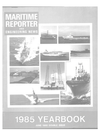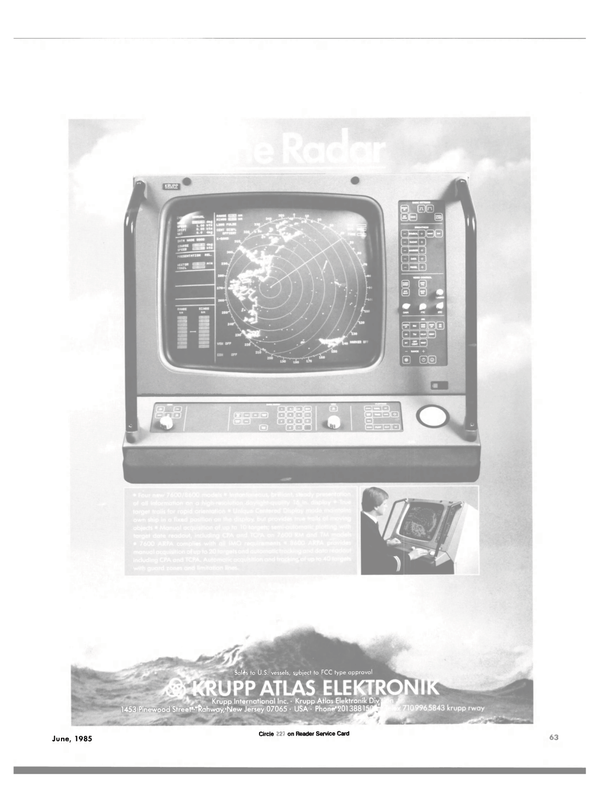
U.S. COULD LEARN A LESSON FROM GREAT BRITAIN'S OFFSHORE OIL LEASING
The current "oil glut" and the oversupply of natural gas have lulled Americans into a false sense of energy security. If something is not done to speed up the pace of domestic energy exploration and production, we will find ourselves more dangerously dependent on foreign energy suppliers in the not-toodistant future.
We have the capability to become energy independent by developing this nation's Outer Continental Shelf (OCS). The OCS is estimated to contain as much as 44 billion barrels of oil and 231 trillion cubic feet of natural gas.
But offshore energy is not a spigot that can be turned on at will. It takes an average of seven years from the time exploration starts until production of oil and gas can begin.
This means that we should be looking today for the energy that our nation will need in 1992. Yet America's development of its OCS has been slow and relatively unsuccessful in comparison with other countries.
Take Great Britain, for example.
Until the mid-1960s, Great Britain imported virtually all of its oil and gas. However, after implementing a major licensing program to open the North Sea to exploration and production, Britain has moved from total dependence on foreign imports to independence. In less than 20 years, it has become a net exporter and the world's fifth largest oil producer.
The United States, on the other hand, currently imports about onethird of the oil it consumes. We can expect foreign imports to increase significantly unless new domestic supplies are found soon.
The U.S. took an important step toward energy independence in 1982 by implementing a concept that Great Britain has used very successfully for many years—areawide leasing. The Department of the Interior adopted this approach when they created the present five-year plan to expedite exploration and development of the OCS. For 28 years prior to that, offshore lands had been offered for lease under a "nomination" system, in which the federal government offered a limited number of specific tracts for leasing based on their geological prospects.
Since its inception, the five-year areawide leasing program has been a subject of intense controversy, attracting both strong support and severe criticism. Hoping to resolve some of the conflict, Interior Secretary Donald Hodel recently issued the first draft proposal of a new five-year program that reduced the pace of leasing activities and changed the original concept of areawide leasing.
It is unfortunate that the Department of the Interior feels compelled to take this action, because Great Britain's track record proves that the areawide approach works. While the U.S. "nomination" leasing program was in effect between 1954 and 1982, only 4 percent of the nearly 1-billion-acre OCS was offered for lease, and only 22 million acres were actually leased.
In the first two rounds of Great Britain's offshore program in 1964 and 1965, however, 113 million acres were offered and nearly 27 million acres were licensed (the British government grants licenses to explore and develop rather than leasing tracts). In just those two years, Great Britain licensed more acreage than the U.S. leased in 28 years.
And in 16 years, the British government licensed nearly 58 million acres, more than twice what would have been offered for lease under the original U.S. five-year plan.
The result of licensing this acreage has been a steady increase in British offshore exploration and production. By 1982, Great Britain was producing an average of more than 2 million barrels of oil daily, nearly twice the daily average offshore production of the United States, which was in decline. The U.S., in fact, was the only nation in the world whose offshore oil production decreased during the 1970s.
The advent of areawide leasing was a shot in the arm for America's ailing offshore industry—at least judging by rig activity in the Gulf of Mexico, a recognized indicator of oil industry health. After bottoming out in mid-1983, the rig utilization rate rose sharply as a direct result of the attractive prospects offered in areawide lease sales.
Instead of making leasing more difficult and restrictive, the federal government should take a clue from the British and remove some of the obstacles hindering OCS development.
We will then have a better chance to reduce our dependence on foreign oil and help insure the nation's energy future.
R. Nelson Crews, president and chief operating officer of Raymond International, Inc. of Houston, Texas, was elected chairman of the National Ocean Industries Association (NOIA) in April 1985. NOIA serves as the legislative and administrative spokesman for the nation's offshore and ocean-related industries.
Its more than 450 companies include offshore drilling contractors, supply boat operators, diving crews, geophysical companies and many other kinds of business involved in ocean and marine-related development.
Read U.S. COULD LEARN A LESSON FROM GREAT BRITAIN'S OFFSHORE OIL LEASING in Pdf, Flash or Html5 edition of June 1985 Maritime Reporter
Other stories from June 1985 issue
Content
- McDermott Gets Contract From SOHIO To Build Offshore Drilling Platform page: 6
- Shipboard Safety Criteria Monitored By Siemens Computer page: 6
- Puroflow Gets Canadian Order For Ultraviolet Water Purification Systems page: 6
- Moss Point Marine To Build Victorian-Style Sternwheel Riverboat page: 7
- Fiberglass Passenger Vessel Built By Westport For Catalina Channel page: 8
- New Facility Opened By Lips Propellers At Todd-Seattle Shipyard page: 9
- Samson Offers Brochure On Passive Mooring Systems For Supply Vessels page: 9
- Marathon LeTourneau To Construct World's Largest Bottom Supported Mobile Offshore Drilling Unit page: 12
- GEC Rolls-Royce Gensets Selected For Shell/Esso Tern Offshore Platform page: 14
- A S S C O Elects B a u m l e r V P - M a r k e t i ng page: 15
- N e w B r o c h u r e F r om W e s t i n g h o u s e Discusses C o m b u s t i o n T r i m C o n t r ol page: 15
- Raytheon Introduces JRC Color And Digital Rasterscan Radar Unit page: 16
- Simpson Timber Restructuring Its Panel Products Division page: 16
- Ingersoll-Rand Signs Sales Agreement With Kawasaki page: 17
- Murray Grainger Resumes Business Activities As Used Equipment Dealer page: 20
- New Remote Control VHF Marine Radio Introduced By Uniden page: 20
- Mitsubishi Introduces Latest Diesel Engine At New York Seminar page: 21
- Contract For Wharf At Cow Head Oil Rig Servicing Facility Awarded page: 22
- Marathon LeTourneau Exhibits Slo-Rol® Motion Suppression Technology During 1985 OTC page: 23
- Aluminum Boats Delivers Whale Watch Excursion Boat page: 23
- I.T.C. Holland Engineers Its Third Double Rig Dry Transport On The Sibig Venture page: 25
- Hitachi Zosen Completes Two Power Generating Barges For Philippines page: 25
- FUTURE U.S. NAVY BUSINESS OPPORTUNITIES —A $230 billion # 5 Year Market— page: 26
- US SHIPBUILDING OUTLOOK Markets & Cost Saving page: 44
- Secretary Dole Promulgates CDS Repayment Rule page: 44
- U.S. MARITIME ASSETS AND NATIONAL SECURITY page: 48
- THE CIRCLE OF RELIANCE " I n Time of War, Land, Sea, and Air Forces and All Logistic Support Functions Must Work as a Team" page: 50
- THE GOVERNMENT AS PARENT TO INDUSTRY: PARTICIPATION OR BENIGN NEGLECT? page: 52
- A SUCCESSFUL MARITIME POLICY UNDER ATTACK page: 58
- Offshore Service Vessels, Tugboat And Inland Towboat Fleets page: 60
- U.S. COULD LEARN A LESSON FROM GREAT BRITAIN'S OFFSHORE OIL LEASING page: 65
- CANADIAN SHIPBUILDING — 1985 — page: 76
- Liu Elected Vice President Of American Bureau To Head R&D Division page: 79
- VTHE NEW DDG-51 CLASS GUIDED MISSILE DESTROYERS —A Report— page: 80
- Harris Gets Subcontract To Supply HF Equipment For Canadian Frigate Program page: 89
- Brochure On "Sea Float" Marine Buoys And Floats Offered By Seaward page: 89
- Multi-Purpose Freighters To Be Built By Seebeck page: 89
- Omnipure Awarded $1.3-Million Contract From Canadian Navy page: 90
- New IMA Report On Future U.S. Navy Procurement Now Available page: 90
- Dubai Drydocks Reports Profit For Second Year page: 91
- Farboil Offers Free Four-Color Folder On Wetsall® Coatings page: 91
- Devoe Offers Brochure On Marine And Corrosion Control Paints & Coatings page: 92
- New Portable Hoists Line With Failsafe Brakes Now Available From PHD page: 92
- World Transport Coordinates Wet Tow Of Western Oceanic Rig page: 93
- Marinette Marine Installs First DWB Ship Transfer System In North America page: 93
- Norcontrol Offers Brochures On Navigation/Instrumentation Line Marketed In U.S. By Nav-Control page: 94
- Nichols Brothers Builds New McNeil Island Ferry page: 97
- Rowan Offers Free Literature On Drill Rig 'Rowan Gorilla IV' page: 97
- Raytheon Introduces Newest SatCom For Fishing And Pleasure Craft page: 98
- Crawford Fitting Introduces Gap Inspection Gages For SWAGELOK Tube Fittings page: 98
- Jeffboat Delivers Deck Barge For Nugent Sand Company page: 99
- Unique Actuator Selection Slide Chart Available From Jamesbury Corp. page: 99
- CRUISE '85 SHIPS • OPERATIONS • SERVICES page: 100
- Aeroquip T-J Division Offers New Series TP Proximity Switches page: 101
- Valcor Catalog Includes Products For Marine And Naval Applications page: 102
- Apelco Introduces Loudhailer With Two-Way Intercom And Alarm Features page: 102
- Marine Management Develops Demo Programs page: 103
- Marco-Seattle Converts Two Combination Crabbers For New Fishery Roles page: 103
- Markey Supplies Tug With Two Capstans page: 104
- Southwest Marine Yard Repowering San Francisco Commuter Ferries With Detroit Diesel Allison Engines page: 104
- AMETEK Announces Computerized Inspection Management System page: 105
- "Marine Library" Literature Available From DDA page: 105
- Furuno Introduces FR-803D Digital Radar page: 105
- MariChem 85 page: 106
- LIQUID CARGO HANDLING EQUIPMENT —A Review— page: 108
- Marathon LeTourneau GranGulf™ Semi Design Offers Economic Construction & Optimum Deck Load page: 113
- First Interactive Shiphandling Simulators From Ship Analytics Being Commissioned page: 116
- Stewart & Stevenson 'Mean 16' Provides Patrol Boats With New Power And Cruising Range page: 119
- Literature Available On Navlink From Datamarine page: 119
- Elliott White Gill Names New Sales Agent For Taiwan page: 120
- Blackinton Named General Manager Of Bethlehem-Beaumont Yard page: 120
- DAMPA Continuous Ceiling Approved By U.S. Navy— page: 121
- Ingersoll-Rand Forms New Compressors Division page: 122
- Menge Named Agent For Seaward Fenders page: 122
- Lanzendorfer Will Manage Fairbanks Morse Service Facility in San Diego page: 124
- $5.3-Million Navy Program Received By Tracor page: 124
- Gensler Named Director Of Marketing And Sales For InterTrade Industries page: 124
- WABCO Offers 8-page Brochure On Logicmaster™ Marine Propulsion Control Systems page: 133
- Free 12-Page Color Brochure Availale From Falk On New Shaft Speed Reducer Line page: 133


